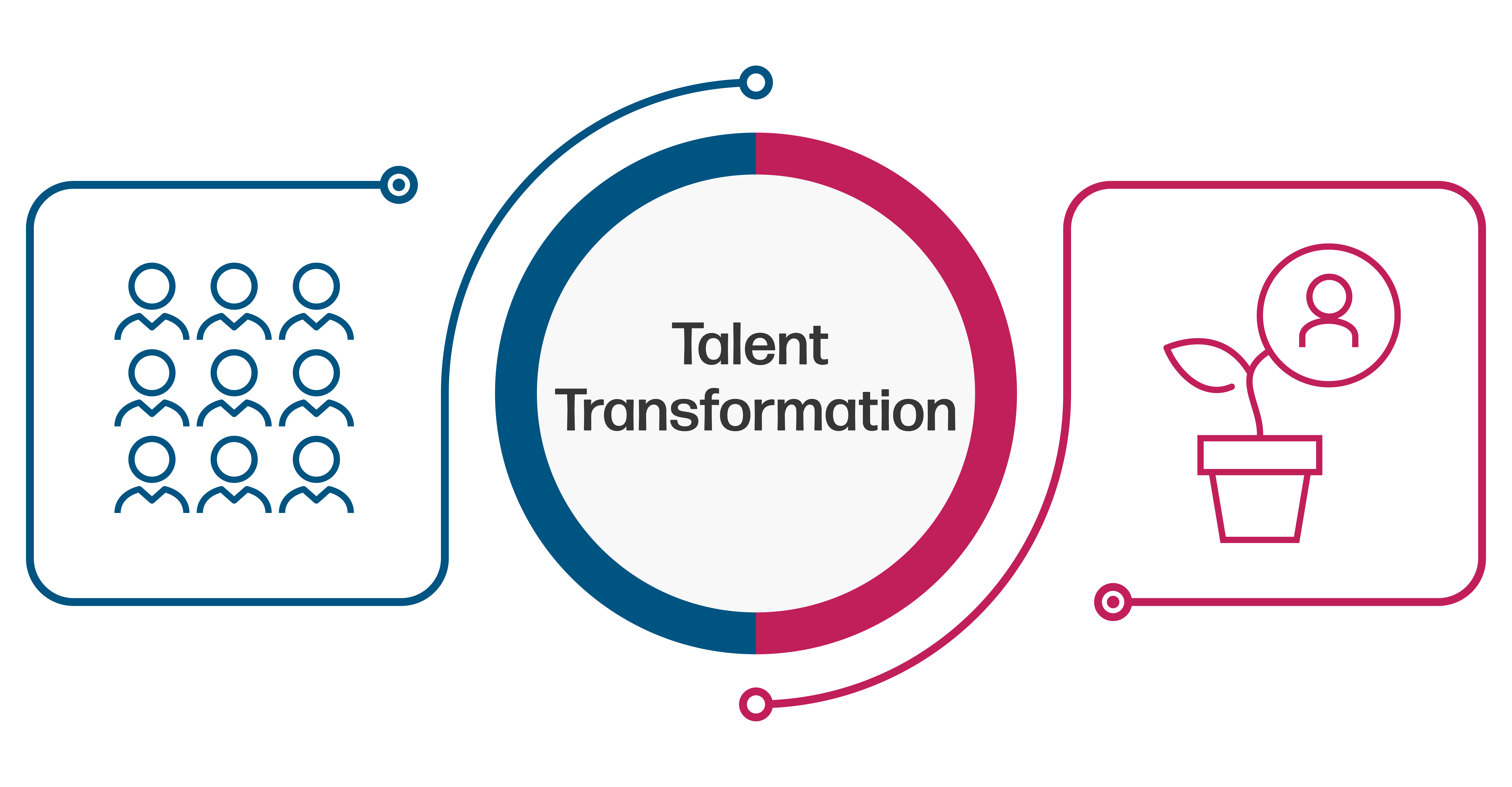The success of any enterprise rests fundamentally on the capabilities of its people. As businesses strive to compete and innovate in the age of intelligence, talent transformation is imperative for growth and sustainability.
People are the heart of an organization’s success. Investing in them and strategizing so that they drive business outcomes is critical for sustaining innovation and growth. Without up-to-date skills and capabilities, an organization cannot deliver on its mission, threatening its own market survival. And with the added dimension of artificial intelligence (AI) tools, it is more important than ever to understand the implications that technology can have on your people and the work they do.
Talent transformation requires more than a superficial communication of new expectations. To unlock potential in your workforce, embrace a holistic approach to talent transformation that is systemic, systematic, sustainable, and—above all—genuinely transformative.

What Is Talent Transformation?
Rather than viewing talent as a static resource, a talent transformation perspective recognizes human potential’s fluid and ever-changing nature. We must constantly harness that potential to adapt and respond effectively to dynamic business environments.

Defining Talent Transformation
Talent transformation means developing, nurturing, and deploying your people’s talent toward a clear and compelling vision. It involves identifying and fostering people’s skills, capabilities, and potential and leveraging technologies—like AI—that enable your organization’s evolving needs and business goals. Fundamentally, a commitment to talent transformation rejects the notion of people as disposable assets. It embraces the human potential for change.
By definition, talent transformation is antithetical to outdated, legacy human resources (HR) mindsets. Traditional HR practices often involve shifting talent based on business needs, employing a supply-chain metaphor. Adherents to this paradigm view people as labor to be deployed, akin to physical assets in a warehouse. They focus heavily on strategic management, the financial consequences of labor, and controlling benefit costs and compliance. They treat people as resources to be managed.
A talent transformation perspective centers the business on people. Instead of viewing them as mere deployable tools, perceive people as assets requiring growth and development. Recognize that emotions and untapped potential are hard to quantify. Talent transformation aims to engage these individuals fully, discern their value beyond measurable outputs, and consider future possibilities. Talent transformation embraces the human side of business and appreciates the significance of employee well-being and fulfillment.
Talent transformation embraces the human side of business.
This contrast means that we cannot simply adopt a legacy HR approach and expect to succeed in talent management. A shift to talent transformation requires fundamental differences in perspective and embracing a people-centric philosophy that nurtures and cherishes each person’s potential.
A talent transformation strategy that values employees as unique assets emphasizes continuous development and prioritizes employee engagement. This can lead to a more agile, innovative, and successful organization.

The 3 Ss: Criteria Every Talent Transformation Strategy Needs
By embracing talent transformation as a core strategy, your organization can thrive in a rapidly changing business landscape and achieve long-lasting success. Every talent transformation strategy should strive to be:



For talent transformation to be effective, it must be ingrained into operations at a fundamental level. It involves training people to embrace new approaches and practices while aligning expectations and metrics with the transformed talent landscape.
Talent transformation should not be a one-time endeavor. Instead, make it a cyclical and continuous process that allows people to adapt to meet current and future challenges.
Talent transformation is not a short-term fix. To ensure lasting impact, embed talent development into your culture and strategy. Integrate talent transformation practices into hiring, performance review, onboarding processes, and all facets of the employee lifecycle.
At its core, talent transformation is a means to establish and evolve an organization’s competitive advantage. Developing people is an essential component of encouraging an evolution that is systemic, systematic, and sustainable.
By upskilling, cross-skilling, and reskilling talent, you can enable people to take on new tasks and responsibilities, breaking down traditional departmental silos and fostering collaboration across diverse teams. Cross-skilling could involve blending teams and enabling team functions. For instance, sharing technical insights with people in an engineering firm’s marketing department could inspire them to create better messaging.
3 Key Areas of Upskilling
Talent transformation is a strategic and continuous effort to unlock the full potential of people. It fosters a culture of innovation and builds a competitive advantage for your organization. Because of this, successful talent transformation means embracing and encouraging upskilling.
Successful upskilling usually includes the following steps:
1.
Identify the right people and the skills they need: What specific talents, skills, and potential in your workforce align with your strategic objectives? Recognize and nurture high-potential individuals who can drive your organization’s growth and success.
2.
Develop skills: Invest in continuous learning and development programs to enhance people’s skills and capabilities. A learning culture encourages individuals to expand their skill sets and knowledge, making them more adaptable.
3.
Deploy talent effectively: After upskilling, placing people in the right roles is crucial to execute your organization’s vision. Effective deployment ensures that a workforce with the appropriate skills and expertise supports your strategic goals.
A 5-Point Checklist for Talent Transformation Strategies
When pursuing a talent transformation strategy, organizations sometimes fall short by neglecting essential principles and practices. The following checklist includes vital components for a successful and sustainable talent transformation.
Embed the 3 Ss into the approach.
Talent transformation is neither a one-off endeavor nor a surface-level fix. Organizations often underestimate the need for a systemic, systematic, sustainable approach to transformation. True transformation entails changing your organization’s core operations and values to create an inclusive and diverse culture. For instance, embracing diversity, equity, and inclusion (DEI) goes beyond simply conducting annual training or creating employee resource groups.
Align with the organizational vision.
A common failure point in talent transformation is a lack of alignment with an organization’s vision and goals. It will likely fail if a transformation disconnects from your organization’s desired outcomes or strategic objectives. A clear and articulated vision is essential to guide the transformation process and ensure that efforts lead to the desired business impact.
Clarify and communicate an execution plan.
Organizations need to define what they aim to achieve through talent transformation. Take, for instance, a client of ours. This century-old insurance company succeeded in transforming from being product-based to being customer-centric. This change was only successful because the company’s visionary leader outlined a clear plan to understand and cater to customers’ needs. Then, upskilling and cross-skilling initiatives were able to transform the workforce.
Practice forward-thinking change management.
Change management is crucial for shaping talent transformation. A forward-thinking approach to managing change considers how to effectively shift culture, skillsets, and strategies to adapt to the new environment. Clear communication ensures that people understand the reasons behind the transformation. It helps them feel engaged and supported throughout the process.
Embrace an agile and adaptable approach.
Organizations undergoing talent transformation must embrace new mindsets and approaches while responding to market shifts. Talent transformation prepares the workforce for future challenges that we might not fully understand. For instance, the rise of AI may require upskilling the workforce for roles that are yet to be defined. Many AI tools themselves are rapidly evolving. Organizations need a progressive talent transformation strategy that moves forward gradually, clarifies the approach to upskilling, and plans to adapt as new opportunities arise.
Organizations often underestimate the need for a systemic, systematic, and sustainable approach to transformation.
Unleashing the Power of People
Talent transformation is a complex process that demands a systemic, systematic, and sustainable approach. Organizations must align transformation efforts with their vision and goals. Do so by fostering a forward-thinking change management strategy and progressive talent development. Recognize and address the often-missed aspects of these initiatives so your organization can move toward meaningful, impactful, and demonstrable talent transformation.

About the Authors

Russell Becker was appointed co-CEO of GP Strategies in June of 2023. Prior to that, he served as the Company’s Chief Growth Officer for over five years and has extensive leadership experience helping organizations establish the right organizational strategy and sales discipline to achieve their aggressive growth goals. From 2015 to 2017, he served as President and CEO of AchieveForum. Prior to that, he held various leadership positions including Executive Vice President of Global Sales at Kenexa, a company acquired by IBM. Mr. Becker holds a BA in Psychology & Political Science and a Master of Business Administration from the University of Nebraska-Lincoln.

Bill Maggio became co-CEO of GP Strategies in June of 2023. Since joining GP in 2005, he has served as the Executive Vice President of Organizational Performance Solutions, Senior Vice President of Managed Learning Services, a leader for Strategic Accounts & Partnerships, and has held a variety of other leadership positions. Prior to his work with GP, he was a member of technical staff with Bell Communications Research (Bellcore); co-founded, grew, operated, and sold an IT and network consulting firm; and bought, ran, and subsequently sold a manufacturing and distribution business. Bill holds a BS in Finance and Economics from Mount Saint Mary’s University and an MS in Information Systems Management from the New Jersey Institute of Technology.
